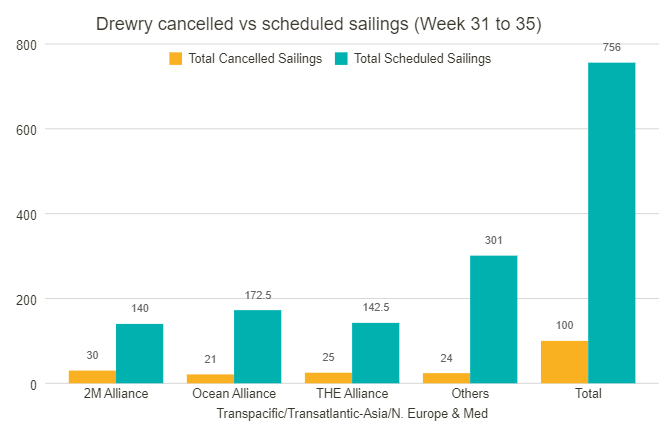The company withdrew the ship, guaranteed the freight rate, suspended the ship in a large area and cancelled 100 voyages!
In the past two years, the sea freight rate has gone up, and once it was hard to find a cabin, which brought a lot of pressure to foreign trade enterprises. At present, the pressure has been relieved a lot. The Shanghai Export Container Freight Index, which represents the spot freight rate, has been falling for seven consecutive weeks. What is the latest ocean freight rate and capacity?
Now it's the peak export season, and many insiders told reporters that the freight rates of most popular routes have declined to varying degrees compared with the same period of last year, while the Shanghai export container freight rate index, which represents the spot freight rate, just announced today, is 3,887.85, down 108.92 from last week, and it has fallen for seven consecutive weeks.
The freight rates of major routes in the latest phase all fell:
In the Far East and West America, it fell by 28 USD to 6,694 USD /FEU, a decrease of 0.4%;
Far East to the East fell by 98 USD to 9,348 USD /FEU, a decrease of 1%;
The freight rate to Far East Europe is 5416 USD /TEU, down 154 USD or 2.7% from last week;
The freight rate to the Far East Mediterranean is $5,971 /TEU, down $230 or 3.7% from last week.
In Southeast Asia, it was USD 968 /TEU, down USD 48 or 4% from last week.
Persian Gulf route, the freight rate is $2,789 /TEU, down 6.1% from the previous period.
Australia-New Zealand routes continue to fall, with a price of 2,997 USD /TEU, down 4.6% from the previous period.
South American routes, after rising for several consecutive weeks, fell back, with a freight rate of 9,439 USD /TEU, down 0.5% from the previous period.
According to the latest data released by Drewry in this issue, in the next five weeks (weeks 31-35), the three major shipping alliances in the world cancelled 76 voyages. Among them, the most cancelled voyages are 30 voyages in 2M Alliance; THE alliance reached 25 voyages, and the least maritime alliance cancelled 21 voyages。

Among the 756 scheduled voyages on major routes such as trans-Pacific, trans-Atlantic, Asia-Northern Europe and Asia-Mediterranean, 100 voyages were cancelled between the 31st and 35th weeks, with a cancellation rate of 13%. According to the current data of Drewry, during this period, 68% of air traffic will occur on the trans-Pacific eastbound trade routes.
In Europe, container hubs with high yard density are struggling to transport containers out of terminals, while in Germany and Britain, labor shortages caused by strikes in ports and railways, as well as severe congestion in Rotterdam and Hamburg ports, are putting more pressure on the already overwhelmed supply chain.
Due to the increasing congestion of European terminals and the increase of the detention time of imported containers, the utilization rate of the storage yard continues to rise and the workload is high, thus adversely affecting the operation, throughput and resources of the terminals.
Therefore, more and more terminals are trying to solve the problem of long-term stranded containers through various measures, including transferring containers to separate storage areas and/or imposing additional one-time and/or daily charges on imported long-term stranded containers.
Recently, HMM, the shipping company, has issued an announcement to remind customers to pick up imported containers as soon as possible during the free period to avoid these surcharges; Otherwise, the extra surcharge levied by the terminal will only be transferred to the customer.
The backlog of goods continues to plague North America and Europe. Obviously, it will take time for the current market conditions to return to normal. Earlier, a platform released a report saying that shipping companies are adopting a more aggressive air navigation strategy to cope with the decline in demand.
He also said that shipping companies will also adopt "other strategies", including slower sailing, to support freight and mitigate the impact of soaring fuel costs.

